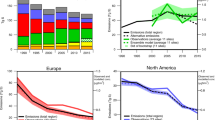Abstract
H2S is a most important biogenic sulfur compound with regard to the atmospheric sulfur cycle. Our present knowledge of the spatial and temporal distribution of this trace gas is rather incomplete owing to unreliable analytical methods. Therefore, a new method for the analysis of H2S in the μg-range was applied. This paper deals with the results of ground- and aircraft measurements of H2S in unpolluted air over swamps and tidal flats. Based on the measured vertical distributions a removal coefficient of 2.3×10−5 sec−1 and an average lifetime of 12 hours were calculated. Some conclusions of the contribution of H2S to the atmospheric sulfur budget are added.
Similar content being viewed by others
References
Claude, H. (1977),Untersuchung der Konzentrationsverteilung von Schwefelwasserstoff in der unteren Troposphäre, Diplomarbeit, Univ. Frankfurt/M.
Cox, R. A. andSandalls, F. J. (1974),The photo-oxidation of hydrogen sulphide and dimethyl sulphide in air, Atmos. Environm.8, 1269–1281.
Georgii, H.-W. (1975),Die aerosolbildenden Spurengase, Promet5, 21–25.
Jaeschke, W. andHaunold, W. (1977),New methods and first results of measuring atmospheric H2Sand SO2 in the ppb Range in Proc. WMO Conf: Air. Pollution Measurement Techniques, Gothenburg, Sweden (1976), Special Environmental Report No. 10.
Junge, C. E. (1972),The cycle of atmospheric gases — natural and man made, Quart. J. Roy. Met. Soc.98, 711–729.
Kellogg, W. W., Cadle, R. D., Allen, E. R., Lazrus, A. L. andMartell, E. A. (1972),The sulfur cycle, Science175, 587–596.
Natusch, D., Klonis, H., Axelrod, H., Teck, R. andLodge, J. (1972),Sensitive method for measurement of atmospheric hydrogen sulfide, Anal. Chem.44, 12, 2067–2070.
O'Brien, J. J. (1970),A note on the vertical structure of the eddy exchange coefficient in the planetary boundary layer, J. Atmos. Sci.27, 1213–1215.
Perner, D., Ehhalt, D. H., Pätz, H. W., Platt, U., Röth, E. P. andVolz, H. (1976),OH-Radicals in the lower troposphere, Geophys. Res. Letters,3, 8, 466–469.
Robinson, E. andRobbins, S. A.,Gaseous atmospheric pollutants from urban and natural sources inThe Changing Global Environment (S. F. Singer, ed.), (D. Reidel Publ. Comp. Dordrecht, Holland, 1975).
Schlegel, H. G. (1974),Production, modification and consumption of atmospheric tracegases by microorganisms, Tellus26, 11–19.
Stuhl, F. (1974),Determination of the rate constant for the reaction OH+H2Sby a pulsed photolysisresonance fluorescence method, Ber. d. Bunsen Ges.,78, 3, 230–232.
Wang, C. C., Davis, L. I., Wu, C. H., Japar, S., Niki, H. andWeinstock, B. (1975),Hydroxy radical concentrations measured in ambient air, Science,189, 797–800.
Author information
Authors and Affiliations
Rights and permissions
About this article
Cite this article
Jaeschke, W., Georgii, HW., Claude, H. et al. Contributions of H2S to the atmospheric sulfur cycle. PAGEOPH 116, 465–475 (1978). https://doi.org/10.1007/BF01636900
Received:
Issue Date:
DOI: https://doi.org/10.1007/BF01636900




